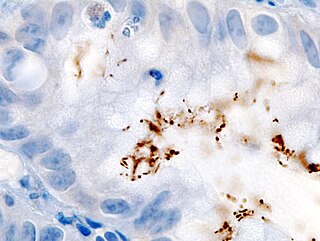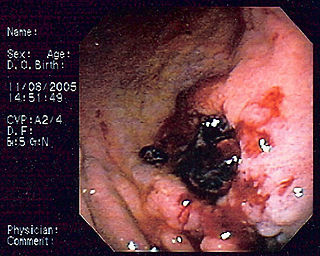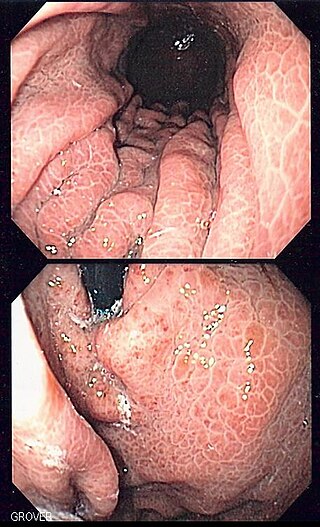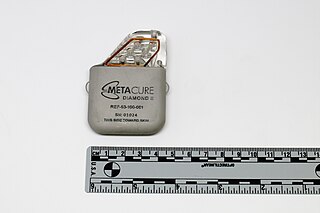Related Research Articles

The persimmon is the edible fruit of a number of species of trees in the genus Diospyros. The most widely cultivated of these is the Oriental persimmon, Diospyros kaki – Diospyros is in the family Ebenaceae, and a number of non-persimmon species of the genus are grown for ebony timber. In 2019, China produced 75% of the world total of persimmons.

Helicobacter pylori, previously known as Campylobacter pylori, is a gram-negative, microaerophilic, spiral (helical) bacterium usually found in the stomach. Its helical shape is thought to have evolved in order to penetrate the mucoid lining of the stomach and thereby establish infection. The bacterium was first identified in 1982 by the Australian doctors Barry Marshall and Robin Warren. H. pylori has been associated with cancer of the mucosa-associated lymphoid tissue in the stomach, esophagus, colon, rectum, or tissues around the eye, and of lymphoid tissue in the stomach.

Upper gastrointestinal bleeding is gastrointestinal bleeding in the upper gastrointestinal tract, commonly defined as bleeding arising from the esophagus, stomach, or duodenum. Blood may be observed in vomit or in altered form as black stool. Depending on the amount of the blood loss, symptoms may include shock.

A Meckel's diverticulum, a true congenital diverticulum, is a slight bulge in the small intestine present at birth and a vestigial remnant of the omphalomesenteric duct. It is the most common malformation of the gastrointestinal tract and is present in approximately 2% of the population, with males more frequently experiencing symptoms.

Gastrointestinal bleeding, also called gastrointestinal hemorrhage (GIB), is all forms of bleeding in the gastrointestinal tract, from the mouth to the rectum. When there is significant blood loss over a short time, symptoms may include vomiting red blood, vomiting black blood, bloody stool, or black stool. Small amounts of bleeding over a long time may cause iron-deficiency anemia resulting in feeling tired or heart-related chest pain. Other symptoms may include abdominal pain, shortness of breath, pale skin, or passing out. Sometimes in those with small amounts of bleeding no symptoms may be present.
Lithotripsy is a non-invasive procedure involving the physical destruction of hardened masses like kidney stones, bezoars or gallstones. The term is derived from the Greek words meaning "breaking stones".

Gastrointestinal perforation, also known as ruptured bowel, is a hole in the wall of part of the gastrointestinal tract. The gastrointestinal tract includes the esophagus, stomach, small intestine, and large intestine. Symptoms include severe abdominal pain and tenderness. When the hole is in the stomach or early part of the small intestine, the onset of pain is typically sudden while with a hole in the large intestine onset may be more gradual. The pain is usually constant in nature. Sepsis, with an increased heart rate, increased breathing rate, fever, and confusion may occur.

A foreign body (FB) is any object originating outside the body of an organism. In machinery, it can mean any unwanted intruding object.

Gastric antral vascular ectasia (GAVE) is an uncommon cause of chronic gastrointestinal bleeding or iron deficiency anemia. The condition is associated with dilated small blood vessels in the pyloric antrum, which is a distal part of the stomach. The dilated vessels result in intestinal bleeding. It is also called watermelon stomach because streaky long red areas that are present in the stomach may resemble the markings on watermelon.

Primary gastric lymphoma is an uncommon condition, accounting for less than 15% of gastric malignancies and about 2% of all lymphomas. However, the stomach is a very common extranodal site for lymphomas. It is also the most common source of lymphomas in the gastrointestinal tract.

Argon plasma coagulation (APC) is a medical endoscopic procedure used to control bleeding from certain lesions in the gastrointestinal tract. It is administered during esophagogastroduodenoscopy or colonoscopy.

Endoscopic foreign body retrieval refers to the removal of ingested objects from the esophagus, stomach and duodenum by endoscopic techniques. It does not involve surgery, but rather encompasses a variety of techniques employed through the gastroscope for grasping foreign bodies, manipulating them, and removing them while protecting the esophagus and trachea. It is of particular importance with children, people with mental illness, and prison inmates as these groups have a high rate of foreign body ingestion.
Gastroparesis, also called delayed gastric emptying, is a medical disorder consisting of weak muscular contractions (peristalsis) of the stomach, resulting in food and liquid remaining in the stomach for a prolonged period of time. Stomach contents thus exit more slowly into the duodenum of the digestive tract. This can result in irregular absorption of nutrients, inadequate nutrition, and poor glycemic control.

Portal hypertensive gastropathy refers to changes in the mucosa of the stomach in patients with portal hypertension; by far the most common cause of this is cirrhosis of the liver. These changes in the mucosa include friability of the mucosa and the presence of ectatic blood vessels at the surface. Patients with portal hypertensive gastropathy may experience bleeding from the stomach, which may uncommonly manifest itself in vomiting blood or melena; however, portal hypertension may cause several other more common sources of upper gastrointestinal bleeding, such as esophageal varices and gastric varices. On endoscopic evaluation of the stomach, this condition shows a characteristic mosaic or "snake-skin" appearance to the mucosa of the stomach.

An esophageal food bolus obstruction is a medical emergency caused by the obstruction of the esophagus by an ingested foreign body.

Nausea is a diffuse sensation of unease and discomfort, sometimes perceived as an urge to vomit. While not painful, it can be a debilitating symptom if prolonged and has been described as placing discomfort on the chest, abdomen, or back of the throat.

One of the most common locations for a foreign body is the alimentary tract. It is possible for foreign bodies to enter the from the mouth, or from the rectum.

A bezoar is a mass often found trapped in the gastrointestinal system, though it can occur in other locations. A pseudobezoar is an indigestible object introduced intentionally into the digestive system.

Gastric electrical stimulation, also known as implantable gastric stimulation, is the use of specific devices to provide electrical stimulation to the stomach to try to bring about weight loss in those who are overweight or improve gastroparesis.
Carbonated soda treatment of phytobezoars is the use of carbonated soda to try to dissolve a phytobezoar. Bezoars consist of a solid and formed mass trapped in the gastrointestinal system, usually in the stomach. These can also form in other locations.
References
- 1 2 3 Chisholm, E. M.; Leong, H. T.; Chung, S. C.; Li, A. K. (1992). "Phytobezoar: An uncommon cause of small bowel obstruction". Annals of the Royal College of Surgeons of England. 74 (5): 342–344. PMC 2497638 . PMID 1416706.
- ↑ Rubin, M.; Shimonov, M.; Grief, F.; Rotestein, Z.; Lelcuk, S. (1998). "Phytobezoar: A rare cause of intestinal obstruction". Digestive Surgery. 15 (1): 52–54. doi:10.1159/000018586. PMID 9845563.
- 1 2 3 4 5 Zhang, R. L.; Yang, Z. L.; Fan, B. G. (2008). "Huge gastric disopyrobezoar: A case report and review of literatures". World Journal of Gastroenterology. 14 (1): 152–154. doi:10.3748/wjg.14.152. PMC 2673384 . PMID 18176981.
- 1 2 Iwamuro M.; Okada H.; Matsueda K.; Inaba T.; Kusumoto C.; Imagawa A.; Yamamoto K. (2015). "Review of the diagnosis and management of gastrointestinal bezoars". World Journal of Gastrointestinal Endoscopy. 7 (4): 336–345. doi:10.4253/wjge.v7.i4.336. PMC 4400622 . PMID 25901212.
- 1 2 Ladas, S. D.; Kamberoglou, D.; Karamanolis, G.; Vlachogiannakos, J.; Zouboulis-Vafiadis, I. (2013). "Systematic review: Coca-Cola can effectively dissolve gastric phytobezoars as a first-line treatment". Alimentary Pharmacology & Therapeutics. 37 (2): 169–173. doi: 10.1111/apt.12141 . ISSN 0269-2813. PMID 23252775.
- ↑ Plataras, C.; Sardianos, N.; Vlatakis, S.; Nikas, K. (2014). "Lentil soup bezoar". BMJ Case Reports. 2014: bcr2013203316. doi:10.1136/bcr-2013-203316. PMC 3987561 . PMID 24692381.
- 1 2 3 Ladas, S. D.; Kamberoglou, D.; Karamanolis, G.; Vlachogiannakos, J.; Zouboulis-Vafiadis, I. (January 2013). "Systematic review: Coca-Cola can effectively dissolve gastric phytobezoars as a first-line treatment". Alimentary Pharmacology & Therapeutics. 37 (2): 169–173. doi: 10.1111/apt.12141 . PMID 23252775.
- ↑ DiMarino, Anthony (2002). Gastrointestinal disease : an endoscopic approach. Thorofare, NJ: Slack. p. 551. ISBN 1556425112.